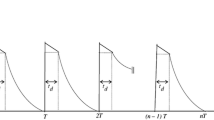Abstract
This paper deals with an EOQ model of an inventory problem with a two-component demand rate:
-
(i)
For a certain period the demand rate is quadratic depending on stock.
-
(ii)
For the rest of the cycle the demand rate is constant.
Price breaks are also taken into account. Effects of deterioration are considered.
This paper considers an EOQ model with a two-component demand rate, deterioration of items and price breaks. Shortages are allowed. The effectiveness of this model is illustrated with a numerical example and sensitivity analysis has been performed.
Similar content being viewed by others
References
Teng, J.T. and Chang, C.T. (2005), “Economic production quantity models for deteriorating items with price and stock dependent demand”, Computers and Operational Research, Vol.32, pp. 297–308.
Rao. K.S. and Sarma. K.V.S. (2004), “An order-level inventory model under L2 system with power pattern demand”. International Journal of Management and Systems, Vol.20, pp. 31–40.
Rau, H; Wu, M.Y. and Wee, H.M. (2004), “Deteriorating item inventory model with shortage due to supplier in an integrated supply chain”, International Journal of System Science, Vol.35(5), pp. 293–303.
Subbaiah, K.V; Rao, K.S and Satyanarayana, B. (2004), “Inventory models for perishable items having demand rate dependent on stock level”, Opsearch, Vol.41(4), pp. 223–236.
Abad, P.I, (2003), “Optimal price and lot size when the supplier offers a temporary price reduction over an interval”, Computers & Operations Research, 30, 63–74.
Arcelus, F.J and Srinivasan, G (2003), “Forward buying policies for deteriorating items under price sensitive demand and temporary price discount”, IJOQM, Vol.9, No.2, 87–101.
Chung, K.J and Hwang, Y.F (2003), “The optimal cycle time for EOQ inventory model under permissible delay in payments”, International journal of Production Economics, 84, 307–318.
Skouri, K, Papachritos, S (2003), “Optimal stoping and restarting production times for an EOQ model with deteriorating items and time-dependent partial backlogging”, International Journal of ProductionEconomics, 81–82, 525–531.
Dye, C.Y (2002), “A deteriorating inventory model with stock dependent demand and partial back-logging under conditions of permissible delay in payments”, Opsearch, Vol.39, No.3 & 4.
Matsuyama, K. (2001), “The EOQ model modified by introducing discount of purchase price or increase of set-up cost”, “International Journal of Production Economics”, 73, 83–99.
Reddy, G.S.N and Sarma, K.V.S (2001), “A periodic review inventory problem with variable stock dependent demand “’Opsearch, Vol.38, No.3, 332–341.
Schniederjans, M.J, Cao, Q, (2000) “A note on JIT purchasing vs. EOQ with a price discount: an expansion of inventory costs”, International Journal of Production Economics, 65, 289–294.
Abad, P.I, (1998), “Determining optimal selling price and lot size when the supplier offers all-unit quantity discounts”, Decisions Sciences, 19, 622–634.
Fazal, F, Fischer, K.P and E.W. Gilbert. (1998) “J.I.T. purchasing vs. EOQ with a price discount. An analytical comparison of inventory costs”, International journal of Production Economics, 54, 101–109.
Jamal, A, Sarkar, B and Wang, S. (l997), “An ordering policy for deteriorating items with allowable shortages and permisiible delay in payments”, Journal of Operational Research Society, 826–833.
Paul, K, Dutta, T.K, Chaudhuri K.S and Pal, A.K, (1996), “An inventory model with two component demand rate and shortages”, Journal of Operational Research Society, 47 1029–1036.
Wee, H (1995), “A deterministic lot size inventory model for deteriorating items with shortage and a declining market” Computers & Operations Research 22, 345–356.
Hwang, H, Moon, D.H and Shinn, S.W. (1990), “An E.O.Q. model with quantity discounts for both purchasing price and freight cost”, Computers & Operations. Research, 17(1), 73–78.
Tersine, R.J and Toelle, R.A, (1985) “Lot size determination with quantity discounts”, Production and Inventory management, 27(3), 1–22.
Rubin, P.A, Dilts, D.M and Barron, B.M,(1983), “Economic order quantities with quantity discounts; Grandma does it best”, Decisions Sciences, 14, 270–281.
Ghare, P.M and Schrader, G.F, (1963) “A model for exponential decaying inventory”, J. Ind. Eng ng, 14, 238–243.
Harris, F.W. (1915) “Operations and cost-factory management series”. A.W. Shaw Chicago. (Ch-4), 48–52.
Author information
Authors and Affiliations
Rights and permissions
About this article
Cite this article
Basu, M., Sinha, S. An ordering policy for deteriorating items with two component demand and price breaks allowing shortages. OPSEARCH 44, 51–72 (2007). https://doi.org/10.1007/BF03398791
Published:
Issue Date:
DOI: https://doi.org/10.1007/BF03398791




